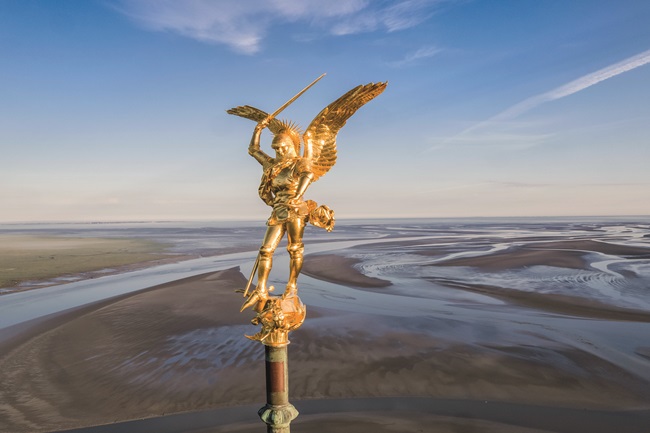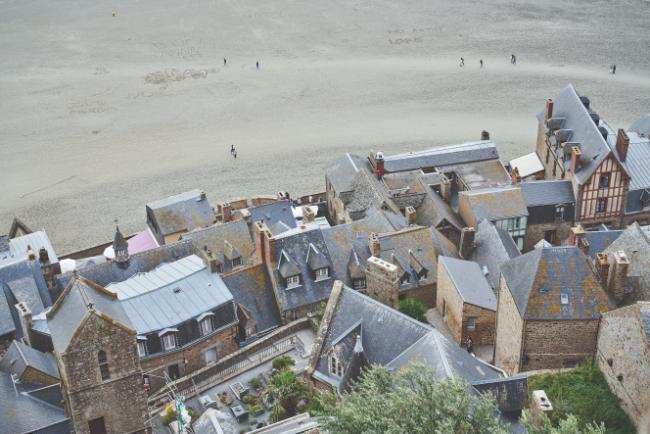The Monumental History of Mont Saint-Michel


France’s most visited regional monument, Mont Saint-Michel, marked its momentous 1,000th anniversary this year. We take a look back at its history and continue to be surprised as we explore it again.
Picture the scene: hundreds of seagulls swarm around the bell tower, the most arresting landmark on this rugged, desolate island by far. Climb high to the choir terrace, far from the chaotic crush of the crowds below, until the raucous squawking of the birds and the ferocious howl of the wind are the only audible sounds. From this high vantage point, the air is astonishingly fresh. At low tide, modern-day pilgrims can be seen trudging barefoot across the bay, making the same once-perilous journey that centuries ago, only the most devoutly religious would have attempted. Then descend back into the warren of rooms in the abbey far below, clambering into one of the tiny, derelict dungeons. The cells, pitch black and completely, eerily, silent, were once a living hell where the only hope of salvation was a wealthy relative conjuring up a ransom payment. Then emerge, blinking, from the gloom, and head back outside.

The archangel on top of the abbey © Centre des Monuments Nationaux
An icon through the ages
From the quietly contemplative spiritualist to the barefoot pilgrim to the royal barricaded in the fortress and scouring the skyline for attackers, to the desperately isolated prisoner despondently awaiting death – in just a few minutes, you’ve walked through centuries of history and played the roles of a whole cast of characters. That’s what’s so special about Mont Saint-Michel – it brings history to life. In fact, the abbey is so popular (it is the most visited regional monument in all of France) that a campaign was recently launched urging the public to remember that there are other landmark locations worth visiting too.
Although the sensible visitor would want to avoid Mont Saint-Michel in peak summer season when the overcrowding reaches the proportions of rush-hour traffic, the monument’s popularity is hugely justified. It’s had its famous supporters too, and in the 19th century, the novelist Victor Hugo was among those campaigning for the abbey’s restoration.
As the world celebrates the monument’s 1,000th anniversary, and the special exhibition, “The Archangel’s Abode’, runs until November 5 in its honour, let’s go back to where it first began. Saint Aubert is credited with founding Mont Saint-Michel. Back in 708AD, when the location was nothing more than a derelict tidal island, he repeatedly had a vision of the Archangel Michael contacting him and commanding him to build an oratory there. He refused, until the archangel is alleged to have poked him in the head, burning a hole through his skull. Spookily, the remains of Saint Aubert’s skull, with what appears to be a hole in it, is available for viewing at the Basilica of Saint-Gervais in nearby Avranches.
Terrifyingly, the likely explanation is that Aubert was subjected to trepanning – an ancient and primitive remedy for various health complaints. In bygone centuries, some held superstitious beliefs that drilling a hole into the head and removing a piece of bone could ease pressure pain underneath, thereby curing headaches, epilepsy and other conditions. In practice, trepanning was dangerous and often fatal.

Mont Saint-Michel is France’s most popular regional landmark © Centre des Monuments Nationaux
A colourful past
The sinister question mark over what really happened to Saint Aubert’s skull can make for a chilling visit, although undoubtedly an historically rich one, with the nearby Scriptorial d’Avranches containing a library of 200 medieval manuscripts from the abbey, dating back as far as the 8th century.
Back at Mont Saint-Michel, you’ll find a tiny chapel dedicated to Saint Aubert’s memory. But the building work he put in was just the beginning: the space quickly became too small for the number of pilgrims who worshipped there, and in 1023, Abbot Hildebert took on the architectural challenge of building atop a rock as he began to develop the abbey’s church further, beginning with the crypt beneath the choir.
In the years that followed, English invaders were repelled, including during the Hundred Years War, due to the strong defensive walls that were crafted. The abbey’s current exhibition, which runs until November 5, displays a fascinating reproduction of the majestic building as it would have appeared during the 17th and 18th centuries – even including the consequences of a fire, which wiped out three of the church’s bays.
Mont Saint-Michel is imbued with history from other eras as well: during the French Revolution, Napoleon had the abbey transformed into a brutal prison, nicknamed the Bastille of the Sea, where hundreds died of starvation or illness while in solitary confinement.
The 19th century proved enormously auspicious for the abbey: in 1862 it was added to the nation’s official list of protected historic monuments; and an aesthetic breakthrough came in 1888, when Victor Petitgrand installed a new tower with a Neo-Gothic spire, taking inspiration from Notre-Dame in Paris. Meanwhile, an early version of today’s throng of tourist shops on the medieval streets below the abbey was lucrative even then, when they were tailored specifically to religious pilgrims. More recently, back in 2007, former French leader Nicolas Sarkozy chose the location to launch his presidential campaign. The abbey may have undergone numerous transformations over the years, but it has never lost the historical context and iconic aesthetic that first earned it such visibility.

© Thomas Thibault / Centre des Monuments Nationaux
A private guided tour of the abbey is highly recommended, as it allows guests to witness areas that are otherwise inaccessible to visitors -for example, certain prison cells that lie behind locked doors, and a secret choir balcony close to the top of the bell tower, which takes you far from the crowds for unforgettable panoramas.
Good entry points for those heading to Mont Saint-Michel from the UK are Rennes and Saint-Malo, as buses, operated by Keolis, run from both locations direct to the island; it’s equally quick and easy to reach for those with their own wheels. If flying into Rennes, it’s impossible to go wrong with a stay at the townhouse hotel Le Nemours, which uses a chic black colour scheme in the style of Coco Chanel. It’s located on a quiet street, yet is close to the heart of town, where some several hundred half-timbered houses expose the city’s medieval heart. It’s a great teaser for the wonders that await at Mont Saint-Michel.
On the other hand, if staying in the legendary walled city of Saint-Malo, the small family-run hotel Les Charmettes is a hidden gem. It directly overlooks the seafront, with the restaurant’s terrace delivering impressive views and allowing diners to descend in just a couple of steps from their tables directly onto the beach. In good weather, the long stretch of water is a hub of social activity, showcasing the city’s ferocious waves. During equinox, the tidal waves are off the scale and quite a spectacle to witness. On the other side of town, they can rise so high into the air that they pass over the city walls and spill below, while crowds gather to watch.
Saint-Malo and the surrounding region apparently boast the highest tides in Europe (up to more than 42ft), which made the ancient pilgrims’ journey to Mont Saint-Michel terrifyingly treacherous and potentially fatal. In centuries gone by, numerous pilgrims lost their lives to drowning, as they dashed across what was then 7km of water, quicksand and mud in a bid to reach dry land before the tides changed. Nowadays, visitors must make the crossing with experienced guides as part of a tour.
Elsewhere in Saint-Malo, for those wishing to be close to the main esplanade, Hôtel Le Nouveau Monde is both comfortable and luxurious and offers easy direct access to the beach. Like Les Charmettes, some of its rooms are sea-facing, and there’s a spa and a high-end restaurant for those needing to unwind.

© Christian Luckman / Centre des Monuments Nationaux
Perfect timing
It’s equally possible to stay on the island itself and for an atmospheric experience, special high-tide evenings take place in July and August each year. Hotel prices there aren’t for the faint-hearted, however, and there are attractive alternatives for those on a strict budget.
The Clos Saint-Gilles is a guesthouse just five miles away from the abbey, in the village of Ardevon, right at the heart of the Mont Saint- Michel bay. Groups of guests often eat breakfast together around the dining table, exchanging stories with the owners, Thibault and Tatiana. Rooms are available in the main house, or, for added privacy, in the atmospheric chapel suite, which combines modernity with religious art. Travel there by car or walk a picturesque path boasting views of the abbey through rural fields and arrive in less than an hour.
The abbey is open 9am-7pm from May I to August 31, and 9:30am-6pm from September I to April 30; it is closed on January 1, May I and December 25.
From France Today magazine
Lead photo credit : Mont Saint Michel turned 1,000 this year © Centre des Monuments Nationaux
Share to: Facebook Twitter LinkedIn Email
More in French history, Mont Saint Michel, monument, Normandy, UNESCO
By Chloe Govan
Leave a reply
Your email address will not be published. Required fields are marked *




REPLY